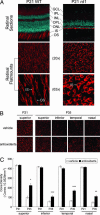Antioxidants reduce cone cell death in a model of retinitis pigmentosa
- PMID: 16849425
- PMCID: PMC1544081
- DOI: 10.1073/pnas.0604056103
Antioxidants reduce cone cell death in a model of retinitis pigmentosa
Abstract
Retinitis pigmentosa (RP) is a label for a group of diseases caused by a large number of mutations that result in rod photoreceptor cell death followed by gradual death of cones. The mechanism of cone cell death is uncertain. Rods are a major source of oxygen utilization in the retina and, after rods die, the level of oxygen in the outer retina is increased. In this study, we used the rd1 mouse model of RP to test the hypothesis that cones die from oxidative damage. A mixture of antioxidants was selected to try to maximize protection against oxidative damage achievable by exogenous supplements; alpha-tocopherol (200 mg/kg), ascorbic acid (250 mg/kg), Mn(III)tetrakis (4-benzoic acid) porphyrin (10 mg/kg), and alpha-lipoic acid (100 mg/kg). Mice were treated with daily injections of the mixture or each component alone between postnatal day (P)18 and P35. Between P18 and P35, there was an increase in two biomarkers of oxidative damage, carbonyl adducts measured by ELISA and immunohistochemical staining for acrolein, in the retinas of rd1 mice. The staining for acrolein in remaining cones at P35 was eliminated in antioxidant-treated rd1 mice, confirming that the treatment markedly reduced oxidative damage in cones; this was accompanied by a 2-fold increase in cone cell density and a 50% increase in medium-wavelength cone opsin mRNA. Antioxidants also caused some preservation of cone function based upon photopic electroretinograms. These data support the hypothesis that gradual cone cell death after rod cell death in RP is due to oxidative damage, and that antioxidant therapy may provide benefit.
Conflict of interest statement
Conflict of interest statement: No conflicts declared.
Figures







Similar articles
-
Antioxidants slow photoreceptor cell death in mouse models of retinitis pigmentosa.J Cell Physiol. 2007 Dec;213(3):809-15. doi: 10.1002/jcp.21152. J Cell Physiol. 2007. PMID: 17520694
-
N-Acetylcysteine promotes long-term survival of cones in a model of retinitis pigmentosa.J Cell Physiol. 2011 Jul;226(7):1843-9. doi: 10.1002/jcp.22508. J Cell Physiol. 2011. PMID: 21506115
-
Oxidative damage is a potential cause of cone cell death in retinitis pigmentosa.J Cell Physiol. 2005 Jun;203(3):457-64. doi: 10.1002/jcp.20346. J Cell Physiol. 2005. PMID: 15744744
-
The mechanism of cone cell death in Retinitis Pigmentosa.Prog Retin Eye Res. 2018 Jan;62:24-37. doi: 10.1016/j.preteyeres.2017.08.004. Epub 2017 Sep 27. Prog Retin Eye Res. 2018. PMID: 28962928 Review.
-
A review of the mechanisms of cone degeneration in retinitis pigmentosa.Acta Ophthalmol. 2016 Dec;94(8):748-754. doi: 10.1111/aos.13141. Epub 2016 Jun 27. Acta Ophthalmol. 2016. PMID: 27350263 Review.
Cited by
-
The impact of macular edema on microvascular and metabolic alterations in retinitis pigmentosa.Graefes Arch Clin Exp Ophthalmol. 2021 Mar;259(3):643-652. doi: 10.1007/s00417-020-04913-3. Epub 2020 Sep 10. Graefes Arch Clin Exp Ophthalmol. 2021. PMID: 32910309
-
Long-term expression of glial cell line-derived neurotrophic factor slows, but does not stop retinal degeneration in a model of retinitis pigmentosa.J Neurochem. 2012 Sep;122(5):1047-53. doi: 10.1111/j.1471-4159.2012.07842.x. Epub 2012 Jul 23. J Neurochem. 2012. PMID: 22726126 Free PMC article.
-
Metabolic and redox signaling in the retina.Cell Mol Life Sci. 2017 Oct;74(20):3649-3665. doi: 10.1007/s00018-016-2318-7. Epub 2016 Aug 20. Cell Mol Life Sci. 2017. PMID: 27543457 Free PMC article. Review.
-
Prolonged blockade of VEGF receptors does not damage retinal photoreceptors or ganglion cells.J Cell Physiol. 2010 Jul;224(1):262-72. doi: 10.1002/jcp.22129. J Cell Physiol. 2010. PMID: 20232317 Free PMC article.
-
The New Era of Therapeutic Strategies for the Treatment of Retinitis Pigmentosa: A Narrative Review of Pathomolecular Mechanisms for the Development of Cell-Based Therapies.Biomedicines. 2023 Sep 28;11(10):2656. doi: 10.3390/biomedicines11102656. Biomedicines. 2023. PMID: 37893030 Free PMC article. Review.
References
-
- Li Z.-Y., Possin D. E., Milam A. H. Ophthalmology. 1995;102:805–816. - PubMed
-
- Ripps H. Exp. Eye Res. 2002;74:327–336. - PubMed
-
- Gupta N., Brown K. E., Milam A. H. Exp. Eye Res. 2003;76:463–471. - PubMed
-
- Leveillard T., Mohand-Said S., Lorentz O., Hicks D., Fintz A.-C., Clerin E., Simonutti M., Forster V., Cavusoglu N., Chalmel F., et al. Nat. Genet. 2004;36:755–759. - PubMed
-
- Yu D. Y., Cringle S. J., Su E. N., Yu P. K. Invest. Ophthalmol. Visual Sci. 2000;41:3999–4006. - PubMed
Publication types
MeSH terms
Substances
LinkOut - more resources
Full Text Sources
Other Literature Sources
Medical
Molecular Biology Databases
Research Materials

